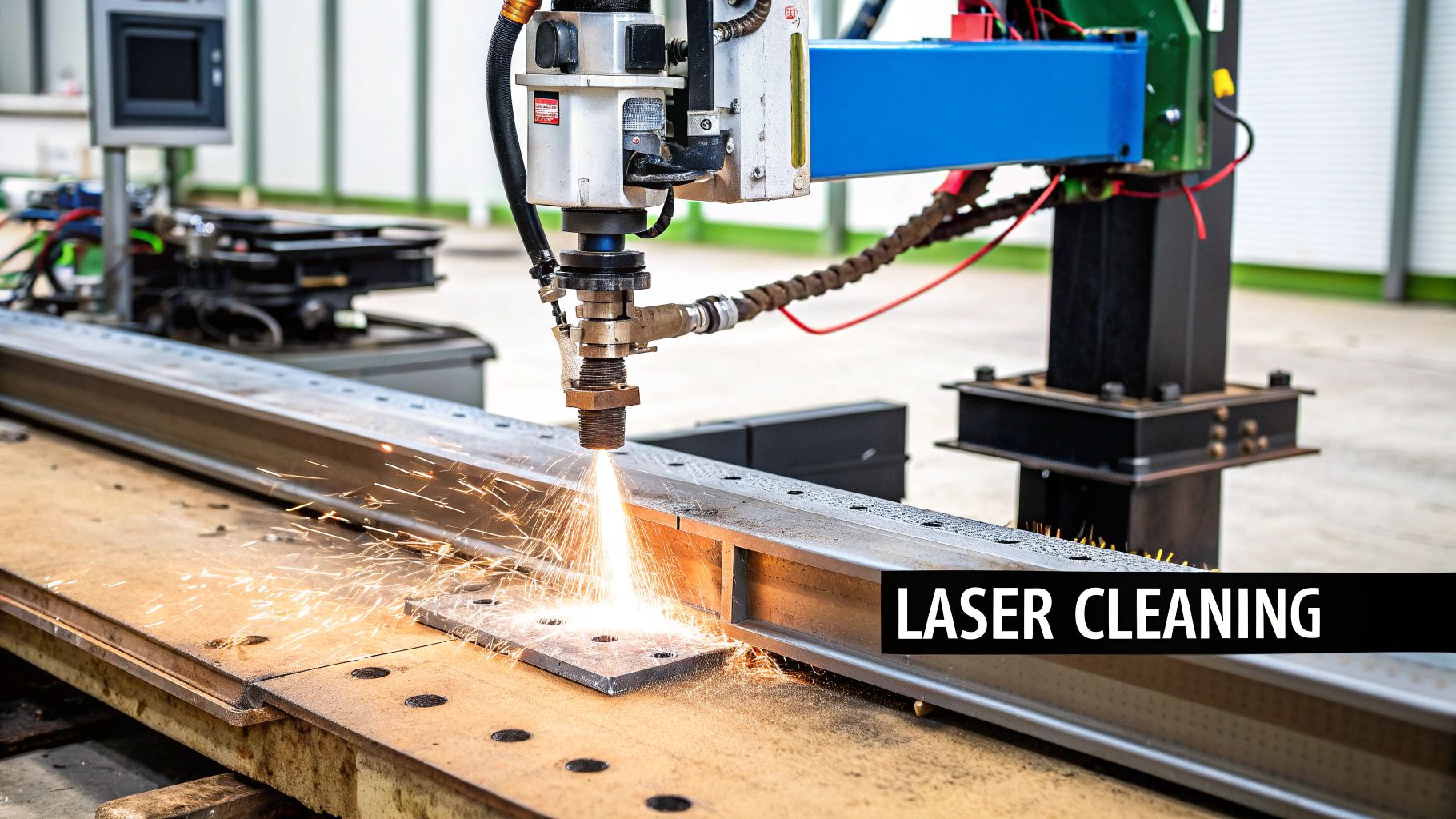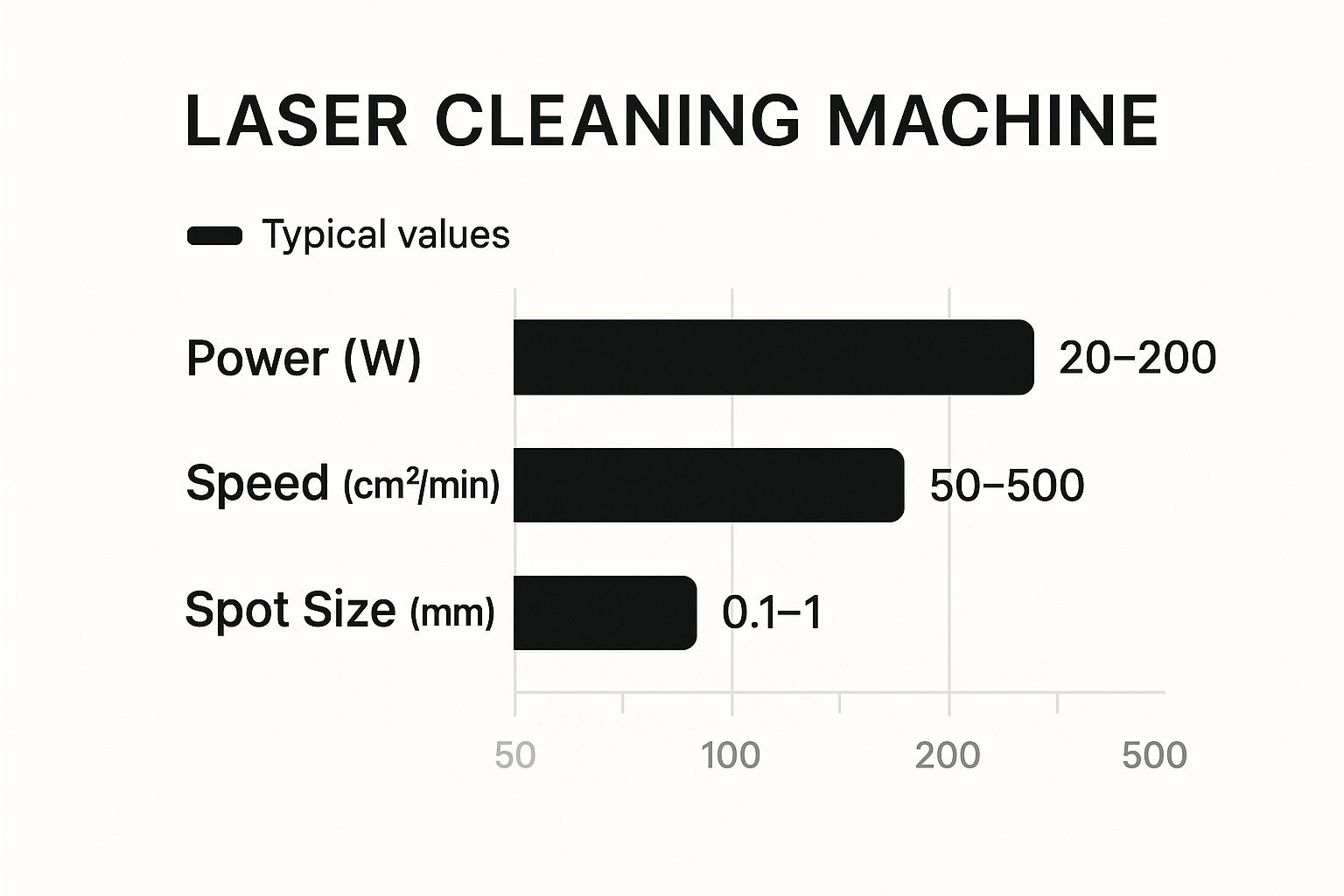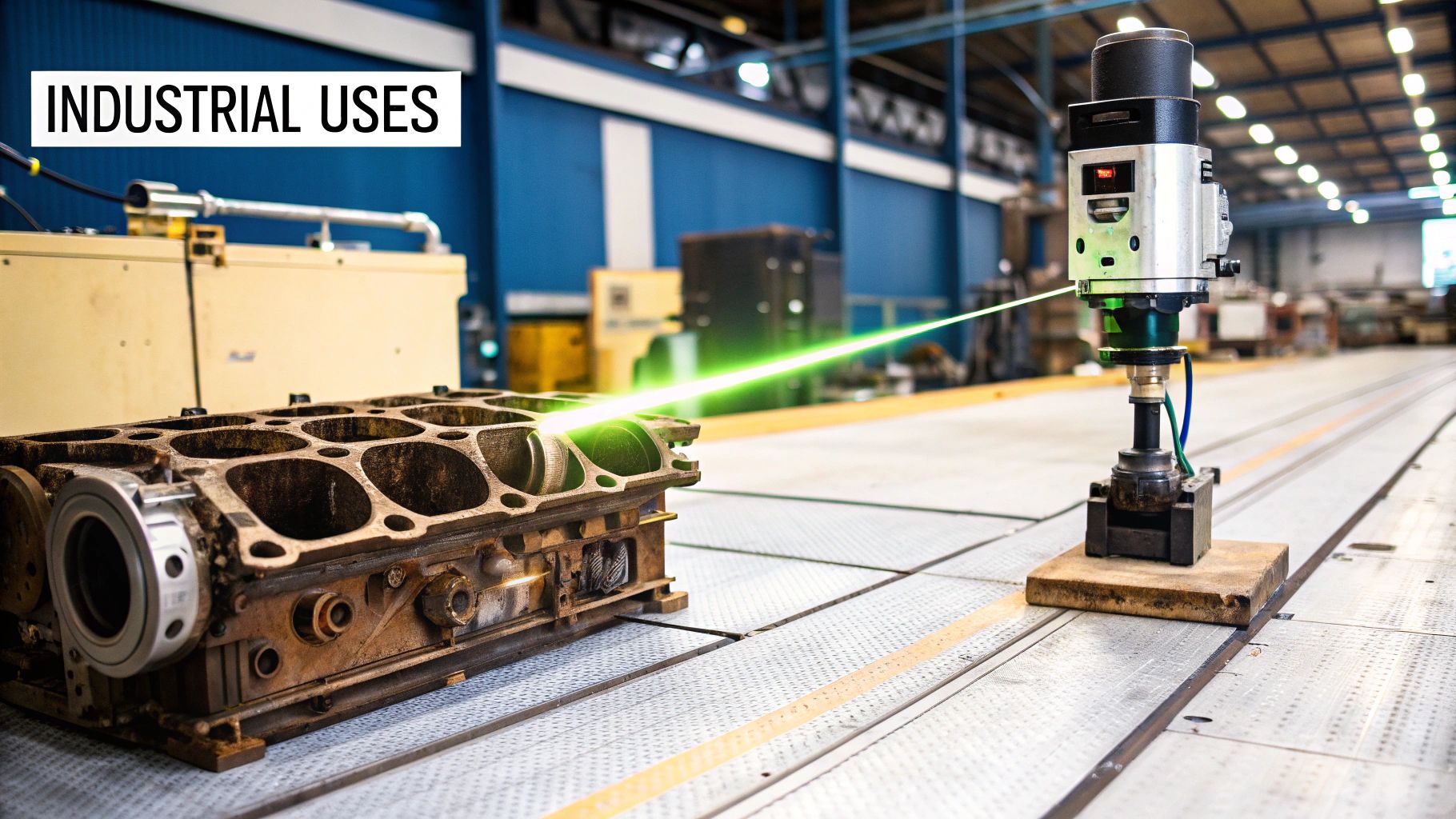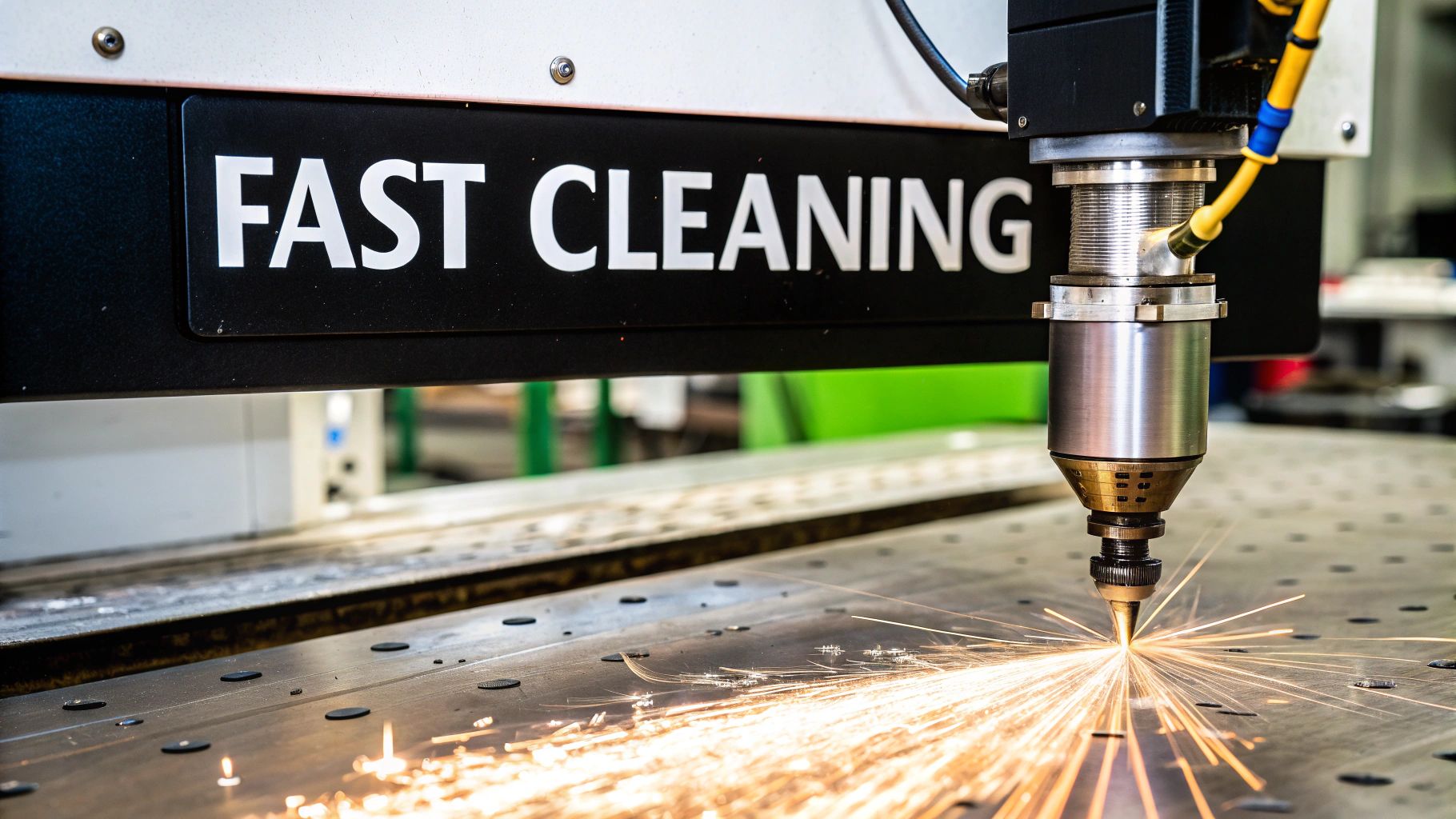Laser Cleaning Machine Guide: Find the Best Solutions Today
- Laserverse

- Jun 9
- 15 min read
Understanding What Makes Laser Cleaning Machines Game-Changers

Laser cleaning machines are rapidly transforming industrial cleaning processes in Canada. This transformation isn't just marketing hype; these machines offer substantial advantages over traditional cleaning methods like chemical solvents and abrasive blasting. Facility managers are increasingly adopting laser cleaning to tackle complex cleaning challenges, particularly those that traditional techniques struggle to address effectively. This shift underscores the growing need for efficient and environmentally sound cleaning solutions.
Precision and Control: The Core of Laser Cleaning
A primary benefit of laser cleaning lies in its precision. Unlike abrasive methods, which can sometimes damage the underlying material, laser cleaning selectively removes contaminants with pinpoint accuracy. This precision is essential for delicate applications like restoring heritage buildings or cleaning intricate machinery components. Furthermore, laser cleaning machines offer a high degree of control over the cleaning process, enabling operators to fine-tune parameters like power and pulse duration to achieve optimal results. This level of control ensures consistent outcomes across diverse materials and contaminants.
Environmental Responsibility: An Increasingly Important Factor
Growing environmental concerns are a significant factor driving the adoption of laser cleaning machines. Traditional cleaning methods frequently involve harsh chemicals that present risks to both human health and the environment. Laser cleaning, in contrast, generates no secondary waste, offering a significantly cleaner and more sustainable solution. This is particularly critical in Canada, where environmental regulations are becoming increasingly stringent. For a deeper understanding of this technology, explore our article on how laser cleaning works. This environmentally responsible approach not only benefits the environment but also helps businesses avoid potentially substantial fines and penalties related to improper waste disposal.
Efficiency and Speed: Enhancing Productivity
Laser cleaning machines can also significantly enhance cleaning efficiency. These machines often clean surfaces much faster than traditional methods, minimizing downtime and boosting overall productivity. For instance, within the automotive industry, laser cleaning is employed to rapidly and efficiently remove rust and paint from car bodies, streamlining the restoration process. This increased speed translates into tangible cost savings for businesses.
Versatility and Adaptability: Addressing Diverse Requirements
Another key strength of laser cleaning machines is their versatility. They can be utilized to clean a broad spectrum of materials, including metal, plastic, stone, and composites. This adaptability makes laser cleaning a valuable asset across various industries, from manufacturing and maintenance to restoration and art conservation. Moreover, the availability of different laser types, such as fiber and CO2 lasers, provides specific advantages for various applications, empowering businesses to select the optimal tool for their particular needs.
Fiber Lasers vs. CO2 Lasers: Key Distinctions
Choosing between fiber and CO2 lasers depends on the specific cleaning application. Fiber lasers, renowned for their high power and precision, are ideally suited for removing rust and paint from metal surfaces. CO2 lasers, conversely, are more effective for cleaning delicate materials like plastics and composites. Understanding these distinctions is crucial for selecting the most appropriate laser cleaning machine for specific cleaning requirements. This ensures that the investment aligns with the desired cleaning outcomes and maximizes operational effectiveness.
The Real Story Behind Investment and Operating Costs
Investing in a laser cleaning machine involves considering both the initial purchase price and ongoing operating expenses. Smart buyers need to look beyond the sticker price to understand the complete financial picture. This includes factoring in everything from electricity consumption and maintenance schedules to truly understand the total cost of ownership.
Initial Investment vs. Long-Term Savings
The initial investment for a laser cleaning machine varies depending on factors like power, features, and automation. While the upfront cost might seem substantial, the long-term savings often outweigh the initial outlay. This is especially true when compared to traditional cleaning methods that use consumables like abrasive media or chemical solvents, which represent recurring expenses. Laser cleaning also minimizes downtime, further contributing to cost-effectiveness. Businesses must weigh these initial investment costs against the long-term benefits. For example, the global laser cleaning market, valued at USD 0.66 billion in 2023, is projected to reach USD 1.15 billion by the forecast period's end. This growth reflects strong demand for laser technology driven by efficiency and environmental benefits. Discover more insights about this growing market. In California, where electricity rates are high, operational costs for a 1000W laser running for 8 hours a day can add up quickly, consuming 8 kWh daily.
Understanding Operational Expenses
Several factors contribute to a laser cleaning machine's operational expenses. Electricity consumption is key, particularly in regions with higher electricity rates like California. The laser's power rating directly impacts energy usage. Regular maintenance, including lens cleaning and replacement, is another important operational cost. The following infographic visualizes key metrics of laser cleaning machines, including typical ranges for power, cleaning speed, and spot size.

As the infographic shows, these machines offer various capabilities, with power ratings from 20W to 200W, cleaning speeds from 50 cm²/min to 500 cm²/min, and spot sizes ranging from 0.1 mm to 1 mm. These variable specifications allow businesses to select the best machine for their needs and budget. Higher power generally means faster cleaning but also higher electricity consumption.
To help illustrate the potential operational costs, let's take a look at a comparison table:
Laser Cleaning Machine Operating Cost Comparison: Comparison of operational costs between different laser power ratings and daily usage scenarios
Power Rating (W) | Daily Usage Hours | Daily Energy Cost (USD)¹ | Monthly Operating Cost (USD)² | Annual Energy Expense (USD)³ |
|---|---|---|---|---|
200 | 4 | 0.80 | 24.00 | 288.00 |
200 | 8 | 1.60 | 48.00 | 576.00 |
500 | 4 | 2.00 | 60.00 | 720.00 |
500 | 8 | 4.00 | 120.00 | 1440.00 |
1000 | 4 | 4.00 | 120.00 | 1440.00 |
1000 | 8 | 8.00 | 240.00 | 2880.00 |
¹ Based on an average electricity cost of $0.10/kWh in California. This can vary. ² Assumes 30 days per month. ³ Assumes 365 days per year.
This table demonstrates how daily usage and power rating significantly affect the long-term operating costs. Choosing the correct power rating for your needs can lead to substantial savings.
Calculating Payback Period
Calculating the payback period for a laser cleaning machine involves considering the initial cost and operational savings. The payback period is the time it takes for cumulative savings to equal the initial investment. This calculation can be complex, depending on factors unique to each business, such as existing cleaning costs, utilization rates, and the specific contaminants removed.
Financing Options
Several financing options are available for businesses considering a laser cleaning machine, including equipment loans, leases, and rent-to-own programs. Each option has advantages and disadvantages depending on a company's financial situation and long-term goals. Leasing can offer lower upfront costs but potentially higher overall long-term expenses.
Maximizing ROI and Minimizing Risk
Several strategies can maximize ROI and minimize financial risks associated with laser cleaning machines. A thorough needs assessment is paramount, ensuring the machine aligns with your applications. Proper operator training is crucial for maximizing efficiency and preventing costly errors. Regular preventative maintenance can help avoid unexpected downtime and extend the equipment's lifespan. Exploring government incentives or rebates for environmentally friendly technologies can further enhance the financial benefits of laser cleaning.
Market Trends That Smart Buyers Should Know About

The laser cleaning machine industry is experiencing rapid growth. However, understanding the key market trends is essential for navigating this expansion. These trends have a direct impact on equipment availability, pricing, and the long-term value of your investment. So, what should informed buyers in California be aware of?
Environmental Regulations Driving Adoption
Stringent environmental regulations are a primary driver of laser cleaning adoption. Traditional cleaning methods often involve harsh chemicals and produce substantial waste. This creates both environmental and regulatory hurdles for businesses. Laser cleaning offers a significantly cleaner alternative. This makes laser cleaning machines an appealing choice for environmentally conscious businesses, particularly in California, known for its progressive environmental policies.
Labor Shortages and Automation
A significant trend is the increasing difficulty in finding skilled labor for traditional cleaning methods. This makes automated solutions, such as laser cleaning systems, increasingly attractive. Automating the cleaning process allows businesses to decrease their reliance on manual labor and enhance operational consistency. This trend contributes to the rising demand, and subsequent price increases, for laser cleaning machines.
North American Leadership in Laser Cleaning
North America, especially the US, plays a major role in the global laser cleaning market's growth. Factors like a robust industrial sector and a growing emphasis on sustainability contribute to this. This dynamic market impacts pricing and product availability, highlighting the need for buyers to remain well-informed. Regional demands further influence the laser cleaning market’s expansion. The North American market is projected to lead the global laser cleaning sector, thanks to its strong industrial base and focus on environmental sustainability. Learn more about the laser cleaning market. For California businesses, laser cleaning aligns with state environmental regulations, offering precision and minimal environmental impact.
Emerging Applications and Technological Innovations
Emerging applications are also fueling the expansion of the laser cleaning market. Industries like aerospace, automotive, and even art restoration are recognizing the advantages of laser cleaning. Concurrent technological advancements are leading to more efficient and affordable laser cleaning machines. These innovations boost performance, lower operating costs, and broaden the applications of laser cleaning technology.
Impact on Equipment Availability and Pricing
The combined effect of these market trends is a high demand for laser cleaning machines. This can influence equipment availability and potentially drive up prices. Understanding these market dynamics is essential for making informed purchasing decisions. Savvy buyers should factor in lead times, potential price fluctuations, and the long-term value retention of their chosen laser cleaning machine.
Industry-Specific Adoption Rates
Adoption rates for laser cleaning vary significantly across industries. Some sectors, such as automotive and aerospace, are rapidly integrating laser cleaning into their operations, while others are in earlier stages of adoption. Factors like specific cleaning needs and the cost-benefit analysis of implementation drive these differences. This variance underscores the importance of researching trends within your specific industry. By understanding these dynamics, businesses can make strategic investments and maximize the return on investment in laser cleaning technology.
Mastering Rust Removal and Surface Prep Applications

Laser cleaning machines are demonstrating exceptional effectiveness in rust removal, providing a level of precision and control not found with traditional methods. This section explores the advantages of laser cleaning for rust removal and surface preparation, with a particular focus on its use in California. From restoring classic cars to cleaning industrial equipment, laser technology is changing how we approach these important tasks.
Why Laser Cleaning Excels at Rust Removal
Laser cleaning offers distinct advantages when it comes to rust removal. The highly focused laser beam targets rust with pinpoint accuracy, leaving the underlying material untouched. This precision is invaluable when working with delicate or complex parts.
Laser cleaning is also a dry process, eliminating the need for harsh chemicals or abrasive materials. This eco-friendly characteristic is especially relevant in California, a state known for its strong environmental regulations.
Finally, the speed and efficiency of laser cleaning minimize downtime, making it a cost-effective solution for businesses.
Real-World Applications in California
Across California, laser cleaning machines are proving useful in diverse applications. In the automotive restoration industry, these machines precisely remove rust from delicate chrome and body panels, helping to restore classic cars to their former glory.
Along California's coast, marine facilities use laser cleaning to combat corrosion on boats and other marine structures without causing damage to the underlying materials. Industrial manufacturers also utilize laser cleaning for surface preparation before painting or coating, ensuring a clean, rust-free surface for optimal adhesion. These examples highlight the versatility of laser cleaning across various sectors in California.
Cost Considerations for California Businesses
The total cost of ownership for a laser cleaning machine includes the initial purchase price and ongoing operational costs, such as electricity and maintenance. For instance, laser lenses require replacement every 1,000 to 2,000 hours of use, and laser sources typically last between 10,000 to 20,000 hours. Understanding these ongoing maintenance costs is crucial for California businesses evaluating the long-term return on investment. Learn more about the costs involved: How to master laser rust removal cost. You can explore this topic further here.
Optimizing Laser Cleaning for Different Rust Conditions
Varying rust conditions and substrate materials require specific laser parameters for optimal cleaning. Light surface rust may only need lower power settings and faster scanning speeds. However, heavier rust often requires higher power and slower speeds. The ability to adjust these settings empowers operators to fine-tune the cleaning process and achieve the best results for each specific application.
Best Practices for Different Substrate Materials
Different substrates respond differently to laser cleaning. Aluminum, for example, requires a different approach than steel due to its higher reflectivity and thermal conductivity. Operators must be aware of these differences to avoid material damage and ensure optimal results. Proper training and careful parameter selection are essential for effective and safe operation.
Maintenance Strategies for Efficient Operations
Regular maintenance is crucial for keeping a laser cleaning machine running efficiently. Routine lens cleaning, proper cooling system maintenance, and adherence to the manufacturer's recommended maintenance schedule can help prevent costly downtime and ensure consistent performance.
Safety First: Essential Precautions
While laser cleaning offers many benefits, safety remains paramount. Operators must receive appropriate training and follow all safety protocols. Wearing proper laser safety eyewear is essential to protect eyes from potential harm. Maintaining a controlled environment, free from flammable materials, also minimizes fire risks. Prioritizing safety protects employees and prevents accidents.
Choosing Your Laser Cleaning Machine Like a Pro
Finding the right laser cleaning machine in Canada can be daunting, given the wide range of options. This guide offers practical advice for navigating the selection process, emphasizing the key factors for a wise investment. We'll bypass the marketing hype and concentrate on features that genuinely contribute to your success. For further reading, see our post on How to choose the right laser cleaning machine in Canada.
Understanding Your Cleaning Requirements
Before diving into the technical specifications, it's vital to assess your cleaning needs. Consider the materials you'll be working with, the contaminants you need to remove, and the required precision. These factors determine the appropriate laser type, power level, and beam delivery system. Delicate materials might benefit from a CO2 laser, while a fiber laser might be better suited for removing tough rust. Defining your cleaning goals will streamline the selection process.
Key Technical Specifications to Consider
With a clear understanding of your requirements, you can evaluate the technical specifications.
Laser Power: Higher power ensures faster cleaning but increases energy consumption. Select a power level that balances speed and cost-effectiveness.
Wavelength: Different wavelengths are suitable for various materials and contaminants.
Beam Delivery System: This dictates how the laser interacts with the surface. Galvanometer scanners offer high-speed precision, while robotic arms handle complex shapes.
Pulse Duration: Shorter pulses provide finer control and minimize heat-affected zones.
Spot Size: A smaller spot size facilitates precise cleaning in tight spaces.
Evaluating Vendors: Beyond the Price Tag
Choosing the right vendor is as crucial as choosing the machine itself.
Service and Support: Opt for vendors known for reliable and efficient service. Customer reviews and testimonials can offer valuable insights.
Training Programs: Comprehensive operator training is essential for maximizing efficiency and safety. Inquire about on-site and online training availability.
Parts Availability: Easy access to replacement parts minimizes downtime. Check lead times for commonly needed parts.
To illustrate the varying capabilities of laser cleaning systems, the following table provides a comparison:
Laser Cleaning Machine Feature Comparison Comprehensive comparison of key features across different laser cleaning system categories
Feature | Entry Level | Mid-Range | Industrial | Benefits |
|---|---|---|---|---|
Laser Power | Low (e.g., 100W) | Medium (e.g., 500W) | High (e.g., 1000W+) | Higher power allows for faster cleaning and can handle thicker contaminants. |
Wavelength | Typically 1064nm (fiber laser) | Various options available | Various options available | Specific wavelengths are optimized for different materials and contaminants. |
Beam Delivery System | Handheld or basic galvanometer scanner | Advanced galvanometer scanners | Robotic arms or integrated systems | More sophisticated systems offer greater precision and flexibility. |
Pulse Duration | Typically longer pulses | Shorter pulse options | Adjustable pulse duration | Shorter pulses minimize heat-affected zones and allow for finer control. |
Spot Size | Larger spot size | Smaller spot size options | Adjustable spot size | Smaller spot sizes are ideal for detailed cleaning in confined areas. |
This table summarizes the key differences in features across various laser cleaning machine categories. Entry-level machines are suitable for basic applications, while industrial systems offer high power and advanced features for complex tasks.
Safety Features: Essential vs. Optional
Safety is paramount in laser cleaning operations.
Laser Class: Laser classes (Class 1 to Class 4) indicate different safety requirements. Class 4 lasers demand stringent precautions, while Class 1 denotes the safest embedded systems. Your machine should meet relevant safety standards.
Protective Enclosures: Enclosures prevent accidental laser exposure. Carefully inspect the enclosure's design and robustness.
Safety Interlocks: Interlocks automatically disable the laser if safety conditions aren't met, such as opening the enclosure. Ensure these are functional.
Emergency Stop Mechanisms: Readily accessible emergency stops are crucial for rapid shutdowns in emergencies.
Total Cost of Ownership: A Long-Term Perspective
Consider not only the initial purchase price but also operating costs, maintenance, and potential downtime. A thorough cost analysis ensures a sound investment.
Negotiation Strategies for the Best Deal
Safety, Maintenance, and Operational Excellence
Excellence in laser cleaning isn't just about having the right machine. It's about prioritizing safety and performing diligent maintenance to protect your team and your investment. This section provides guidance on establishing a safe and efficient laser cleaning operation in California.
Prioritizing Laser Safety in Your CA Workplace
Laser safety is paramount. Different laser cleaning machines use different laser classifications, each with specific safety requirements. Understanding these classifications, as defined by the IEC 60825-1 standard, is critical. Class 1 laser systems, often found in enclosed machines like the Netalux Needle and Jango models from Laserverse, are generally safe during normal operation. However, even with these systems, regular checks and maintenance are essential to ensure enclosure integrity and proper function of safety interlocks.
For operations using higher-class lasers, especially open-beam systems, more stringent measures are crucial. This includes wearing appropriate laser safety eyewear designed for the specific wavelength of your laser, along with protective clothing. Controlling the environment is also vital, ensuring the workspace is free of flammable materials and adequately ventilated to handle laser-generated fumes and particles. For further information, resources like Laser Classes & Laser Safety - What You Need to Know offer valuable insights.
Maintaining Your Laser Cleaning Machine for Optimal Performance
Regular maintenance ensures consistent performance and extends the life of your laser cleaning machine. This includes regularly cleaning the laser lens, a critical component susceptible to contamination. Cleaning frequency may vary from daily to weekly depending on usage. More significant maintenance, like lens replacement, is generally needed after 1,000 to 2,000 hours of use.
Beyond lens care, maintaining the cooling system is crucial, particularly in California's warmer climate. Regularly checking coolant levels and cooling system function prevents overheating and potential damage to the laser source. Power supply protection is also essential. Power fluctuations can impact performance and potentially harm the machine. Using a dedicated power line with surge protection can minimize these risks.
Developing a Culture of Safety and Operational Excellence
Operational excellence transcends equipment and procedures; it requires a culture of safety. This involves fostering an environment where safety is everyone's shared responsibility. Comprehensive training programs for all operators are fundamental. These programs should cover the technical aspects of machine operation, safe practices, emergency procedures, and the importance of proper personal protective equipment (PPE) use.
Regular safety audits and reviews reinforce safe habits and identify potential hazards. Clear communication channels ensure safety concerns are addressed promptly. By prioritizing safety and implementing thorough training, businesses cultivate a work environment that values both productivity and personnel safety.
Troubleshooting and Performance Optimization
Even with diligent maintenance, occasional troubleshooting is inevitable. Understanding common issues, like inconsistent cleaning or reduced power output, allows for quick diagnosis and resolution. Maintaining a log of maintenance activities and performance issues can identify patterns and prevent recurring problems.
Performance optimization complements maintenance. Regularly checking and adjusting laser parameters, such as power, pulse duration, and scan speed, optimizes cleaning efficiency and quality across various materials and contaminants. This consistent attention to detail ensures the machine delivers the desired results.
By prioritizing safety and implementing robust maintenance procedures, California businesses can maximize their laser cleaning investments. This proactive approach protects personnel and equipment while contributing to consistent operational excellence and long-term success.
Key Takeaways
This guide has explored the advantages, costs, market trends, and best practices for laser cleaning machines in Canada, offering valuable insights for making informed purchasing decisions. Here are the key takeaways:
Why Choose a Laser Cleaning Machine?
Precision and Control: Laser cleaning surpasses traditional methods in precision, selectively removing contaminants without harming the base material. This is ideal for detail-oriented applications like restoration or intricate machinery cleaning.
Environmentally Friendly: Unlike chemical solvents and abrasive blasting, laser cleaning is a dry, waste-free process. This aligns with stringent environmental regulations.
Efficiency and Speed: Laser cleaning significantly reduces cleaning time compared to traditional methods, minimizing downtime and boosting productivity. This translates to long-term cost savings.
Versatility: Laser cleaning adapts to various materials, including metal, plastic, stone, and composites, making it useful across diverse industries.
Understanding the Costs
Total Cost of Ownership: Factor in the initial investment and ongoing expenses like electricity and maintenance when budgeting. Regular maintenance, such as lens replacements every 1,000-2,000 hours, contributes to long-term costs.
Return on Investment (ROI): Laser cleaning can offer substantial ROI through increased productivity, reduced downtime, and lower waste disposal costs. Analyze your current cleaning expenses and potential savings to calculate your potential payback period.
Market Trends and Their Implications
Environmental Regulations: Stricter regulations are increasing the demand for cleaner technologies like laser cleaning.
Labor Shortages: The scarcity of skilled labor for traditional methods makes automated solutions like laser cleaning more appealing, influencing demand and pricing.
North American Market Dominance: North America, with its industrial strength and focus on sustainability, is poised to lead the global laser cleaning market.
Choosing the Right Machine
Needs Assessment: First, analyze your specific cleaning requirements. Consider the materials, contaminants, and desired precision to choose the correct laser type and power.
Key Specifications: Focus on essential technical features like laser power, wavelength, beam delivery system, pulse duration, and spot size. Balance power with energy consumption and consider precision-enhancing features.
Vendor Evaluation: Look beyond price. Evaluate vendors on service support, training, parts availability, and industry reputation.
Safety and Operational Excellence
Laser Safety: Prioritize safety by understanding laser classifications and implementing strict protocols, including proper personal protective equipment (PPE) like laser safety eyewear.
Preventative Maintenance: A regular maintenance schedule ensures optimal machine performance and minimizes downtime. This includes lens cleaning, cooling system upkeep, and power supply protection.
Training and Culture: Create a safety culture through comprehensive operator training, regular safety audits, and open communication about safety concerns.
Ready to explore the benefits of laser cleaning? Visit Laserverse, a Canadian provider of advanced laser cleaning solutions, to find the right machine for your business.

